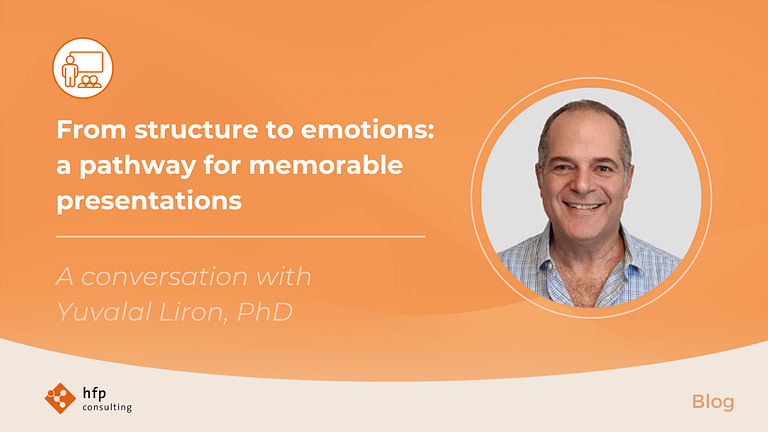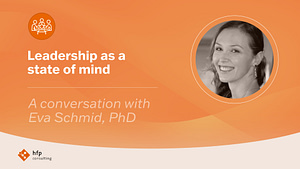
In the world of academia, researchers often find themselves in the presenter’s seat during events, conferences, and congresses. Surprisingly, though, very few are taught the principles of how to deliver a compelling talk, from preparation to presentation to dealing with blackouts and other fears.
This lack of formal training is pervasive across all levels of academia and frequently hinders the effective communication of crucial discoveries. In this post, Yuvalal Liron, a consultant and a trainer at hfp consulting, shares with us valuable insights into gaining confidence and creating a solid framework for any presentation, transforming research into captivating narratives.
Diagnosing the problem
“At its essence, a good presentation is like a well-planned choreography. It doesn’t happen by chance,” says Liron, whose unique vision comes from his experience as a computer scientist, and his work as a theater actor, director and teacher. While structure, movement, intonation, ideas, and emotions all come into play, the correct use of these skills is seldom seen at scientific conferences, where most talks are marred by common pitfalls.
Liron advocates for a departure from data-heavy presentations. “Scientists often delve too deeply into background details and adhere to a chronological format, leading to slide-driven narratives that focus on graphs rather than audience engagement. Such presentations can become tedious and difficult to follow.” Instead, he recommends embracing a narrative that captivates from the start, weaving the research’s dilemmas, mysteries, and resolutions into a compelling story.” This is precisely where the hfp consulting presentation workshop steps in.
Give your science a unique voice
“Many scientists are not comfortable with the notion of ‘selling’ themselves”, explains Liron. “They often feel their work should speak for itself and naturally draw attention. This is not realistic,” he asserts. No matter how brilliant the research is, to bring it into the spotlight you must leave a lasting impact on those who are hearing about it.
In this regard, other professional areas have much to teach scientists. It would be unthinkable for a salesperson, a lawyer, or an actor not to know the basic notions of what makes a good presentation. And since many different scenarios require these skills, there are tried and tested methods to learn and explore.
While this workshop won’t delve into slide design, font choices, or wardrobe selection to impress the audience, it will equip you with the tools to find your authentic voice, charisma, and enthusiasm – the qualities you naturally use when discussing your research with friends over coffee. To start, ask yourself: “Why am I doing what I’m doing, and what sets me apart from others?” These questions are not to be underestimated, advises Liron.
Then, our expert recommends a three-layered method. “The first layer is structure, how you build your story and define the main idea. Just learning how to make a clear choice about your main idea and committing to it can be a game changer.” Then comes performance. “In science, we often think of ourselves as just heads with brains. But we are human beings. On a stage you have a body, you have a voice, and you need to know how to use it,” he adds.
When emotions come into play
In the third layer of his approach, Liron delves into the emotional dimension, which holds varying levels of relevance for scientists during presentations. “Early career researchers, and not only them, often face emotional challenges such as stage fright, the dread of a blackout —which can happen to anyone— and battle with self-doubt,” explains Liron. These can lead to intrusive thoughts, self-sabotage and paralysis, hindering career progression.
Moreover, the emotional aspects of presenting can persist over time. Imposter syndrome for one, does not always disappear with experience and seniority. “It can even become worse,” clarifies Liron, “because the more you’ve achieved, the bigger the fear of having arrived there by chance and that it will all be revealed.”
Following hfp consulting’s core values, participants are given a full toolbox of effective strategies, but most importantly ample time to practice. “In a way, there is an interplay between the three layers. You might have had an unpleasant experience in the past, which affects your body language, how you speak and even how you structure a presentation.” This is why copying others’ presentation styles may not work as intended. Practice and constant feedback are the key to finding what works for you.
“In our workshops, we cultivate a distinctive positive feedback culture to maximize the benefits of peer feedback,” Liron elaborates. “Contrary to the critical judgment that many scientists are accustomed to receiving after their presentations, we promote a cooperative approach. We work together to pinpoint the existing strengths of a presentation and then collaboratively brainstorm ways to enhance and develop it, ensuring feedback is a constructive and supportive process.”
If you’re interested in our Presentation Skills workshop, please contact us for more information.





